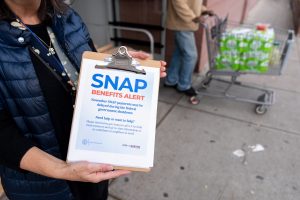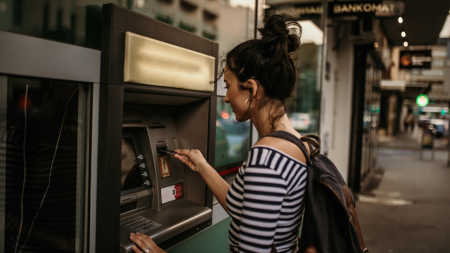SeBrina Bibb’s husband died in 2020, thrusting her into the role of single mom to 3 young kids.
Money challenges quickly piled atop her grief. Income, child care and basic household labor all fell to her. At one point, Bibb and her children were homeless, sleeping on the couches of friends and family.
Unable to afford daycare as a single parent to young children, Bibb couldn’t work. Instead, she stayed home to care for her kids before they were old enough to go to school.
“When I lost him, not only did it affect my mental health, but it definitely affected me financially,” she says.

Today, Bibb is 30 years old and lives in Christiansburg, Va., with her daughters ages 4, 7 and 10. She receives $1,100 in monthly Social Security survivor benefits and uses the Supplemental Nutrition Assistance Program (SNAP) to feed her family.
After paying for groceries, rent, electricity, car insurance, her cellphone and basic necessities like shoes, shampoo and diapers, there’s not much money left. She’s lucky if she saves $20 to $40 per month.
Now that her youngest has started school, Bibb recently got a job as a substitute teacher. She’s hopeful it will lead to career growth and steadier income. But in the meantime, her $120 weekly SNAP benefits — commonly known as food stamps — are a vital element of her budget.
Bibb is one of millions of Americans who rely on food assistance that will be only partially funded by the U.S. Department of Agriculture (USDA) in November, thanks to what is now the longest-ever government shutdown. As these benefits are administered locally, it’s unclear when exactly those payments will come and how much each state will have to step up to help the Americans who rely on them.
The latest decision follows a legal scuffle between the Trump administration and half the states. But the days of back-and-forth haven’t led to greater food security for Americans in need — instead, they’re left scrambling for answers.
What’s next for food aid in America?
Amid the ongoing, ever-changing updates from the federal government, some responsibility is essentially punted to local governments. In response, many states are using emergency funds to cover the remainder of residents’ benefits or support food banks.
When Bibb first heard the rumors that food aid would stop, it kept her up at night. “I will not have money for groceries,” she fretted. She’s since learned the state of Virginia plans to make weekly payments to SNAP recipients for the same amount they normally receive.
Bibb says her panic has subsided since learning how the state will help. Still, her family’s health relies partly on the ability of politicians to reopen the government. “Nobody wants to be in this position where we have to rely on the government,” she admits.
“Are they going to help, or are they not? Do they care, or do they not?” she asks. “It’s not just me and my babies. There are millions of us.”
There are 41.7 million Americans in a similar position as Bibb, to be exact — receiving an average $187.20 in SNAP benefits each month, according to the USDA. The latest hits from the shutdown come on top of uncertainty these Americans already face. The Trump administration’s One Big Beautiful Bill Act signed earlier this year expanded work requirements, ended eligibility for lawful immigrants and complicated qualifications for SNAP. States were also asked to foot more of the bill.
If you’re facing food insecurity, local resources are a great first place to look for help. Many food banks, churches and agencies are organizing food drives. For example, local fraternities and elderly communities have already offered to donate Thanksgiving meals where Bibb lives, according to Kelly Edmonson, the social services director for Montgomery County, Va.
And if you’re looking for ways to be a good neighbor, you can donate food, time or money to the organizations above.
“I just want the bare minimum of what comfortable living is.”
Amid the SNAP drama, Bibb’s kids have suggested other ideas for income, like hosting a yard sale or lemonade stand. It makes her feel guilty. But she’s doing the best she can with what she has.

Bibb says she doesn’t spend much beyond the essentials. She rarely buys herself new clothes or shoes. Instead, she relies on donations, yard sales, and curbside furniture at the nearby college. Still, she’s felt the stigma commonly associated with SNAP recipients — like being called lazy.
But “the majority of people on food stamps don’t want to be on food stamps,” she says.
Likewise, her neighbors are warding off poverty. They work at fast food restaurants, gas stations or Walmart, trying to stay afloat. Many went to high school together or have met at food pantries or in Facebook giveaway groups.
“We have each other’s backs,” Bibb explains. “But a lot of the time, none of us have much to give.”
Her dream of financial independence is simple: reliable income, comfort and a college fund for her kids.
“I don’t have to have a nice house or drive a Mercedes,” she says. “I want to know that I can put food on the table and I don’t have to count pennies for gas every week. I just want the bare minimum of what comfortable living is, and I don’t have to worry about losing it all.”
Why we ask for feedback
Your feedback helps us improve our content and services. It takes less than a minute to
complete.
Your responses are anonymous and will only be used for improving our website.
Help us improve our content
Read the full article here









